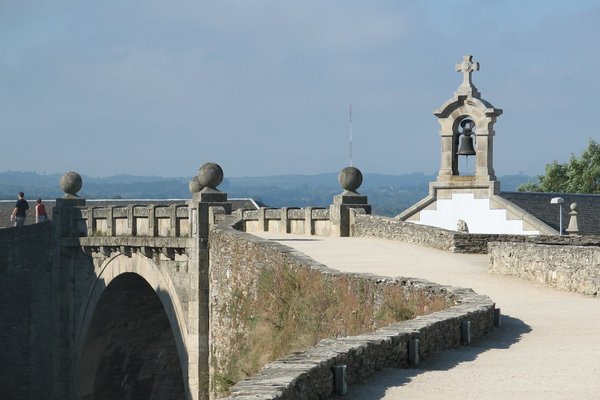Spain
Roman Walls of Lugo
The Roman Walls of Lugo are the only complete and intact urban defensive walls surviving anywhere in the former Roman Empire.
Their circumference is 2,117m and the height varies between 8 and 10m. The width of over 4m provides space for a walkway along the top of the walls. Five of the original gates and numerous interval towers are still intact. Lugo, called Lucus Augusti by the Romans, was a regionally important colonial town. The walls were constructed in the 3rd and 4th centuries CE.
Community Perspective: You can do a full loop of the walls by walking on the ramparts. In town, there is the Centro de Interpretación da Muralla de Lugo in Praza do Campo which gives detailed information on the walls' importance.
Site Info
Official Information
- Full Name
- The Roman Walls of Lugo (ID: 987)
- Country
- Spain
- Status
-
Inscribed 2000
Site history
History of Roman Walls of Lugo
- 2000: Inscribed
- Inscribed
- Type
- Cultural
- Criteria
- iv
Links
- UNESCO
- whc.unesco.org
- Official
-
- concellodelugo.gal — Lugo Turismo
All Links
UNESCO.org
- whc.unesco.org — whc.unesco.org/
Official Website
- concellodelugo.gal — Lugo Turismo
Community Information
- Community Category
- Archaeological site: Ancient Rome
Travel Information
Exact locations inscribed twice (or more)
Recent Connections
-
Perfect Inscriptions
2000 -
Moats
"the walls conserve their original layo… -
Cemeteries
Documents attest to the existence of a …
Connections of Roman Walls of Lugo
- Geography
-
-
Linear inscriptions
The core zone only exists of the rectangular wall, over 2km long and 4m wide
-
- History
-
-
Normans
"The town was to be ravaged once again in 968 by the Normans, on their way to the Mediterranean, and it was not restored until the following century." (AB Ev) -
Sieges and Battles
"Lugo was unable to resist the Suevi when they swept into the peninsula in the early 5th century and destroyed the town by fire. They were to be dislodged in their turn by the Visigoths, who captured the town in 457 and settled it once again. The irresistible Moorish invasion of Spain saw Lugo overwhelmed and sacked in 714, but it was recaptured for Christendom by Alfonso I of Asturias in 755 and restored by Bishop Odarius. The town was to be ravaged once again in 968 by the Normans, on their way to the Mediterranean, and it was not restored until the following century." (AB Ev)
-
- Damaged
-
-
Destroyed during invasion
A section of the wall was destroyed in 984, during the siege of the town by Almanzor. (Nomination file, p. 75)
-
- World Heritage Process
-
-
Perfect Inscriptions
2000 -
Inscribed on a single criterion only
iv. to be an outstanding example of a type of building, architectural or technological ensemble or landscape which illustrates (a) significant stage(s) in human history -
WHS with enclave
Only the complete circle of walls is inscribed - not the city within them -
Exact locations inscribed twice (or more)
Also part of Route of Santiago de Compostela: 669bis-008 Remparts Romains de Lugo
-
- Constructions
-
-
Moats
"the walls conserve their original layout and the construction features associated with their defensive purpose, with walls, battlements, towers, fortifications, both modern and original gates and stairways, and a moat." (OUV) -
Walled cities
-
Cemeteries
Documents attest to the existence of a big cemetery in the vicinity of the wall near the southern part, where it cut the city in two. It is precisely that southern section, between the gates of Saint Peter and Saint James, that has the highest occurence of funerary inscriptions reused in the wall, corresponding to the cemeteries in that sector. (Nomination file, p. 51)
-
- WHS on Other Lists
-
-
World Biosphere Reserves
Terras do Miño (2002)
-
- Timeline
-
-
Built in the 3rd century
between 263 and 276
-
- WHS Hotspots
- Visiting conditions
News
No news.
Recent Visitors
Visitors of Roman Walls of Lugo
- Adam Hancock
- Adolfo
- Adrian Turtschi
- Alberto Rodriguez Gutierrez
- Alexander Barabanov
- Alexander Lehmann
- Alikander99
- Ammon Watkins
- Ana Lozano
- AndreaTLV
- Angela Vandyck
- Anna Wludarska
- Antonio J.
- Argo
- Aspasia
- Atila Ege
- AustralLights
- BaziFettehenne
- Bill Maurmann
- Bin
- Bram de Bruin
- CeeMon
- Cezar Grozavu
- Cheryl
- Christian Wagner
- Christravelblog
- Claire Bradshaw
- Clyde
- Corinne Vail
- CugelVance
- Daniela Hohmann
- Daniel Chazad
- David Berlanda
- Dimitar Krastev
- Dimitrios Polychronopoulos
- Dorejd
- Echwel
- Elaine McArdle
- Els Slots
- Emilia
- Emili Xaus
- emvcaest
- Ertai
- Eva Kisgyorgy
- Evgenii
- fabi-ddorf
- Fan Yibo
- Farinelli
- Feldhase
- Femke Roos
- Filip Murlak
- FS
- George Gdanski
- GeorgeIng61
- Gernot
- Grzegorz Andruszkiewicz
- Harry Mitsidis
- Hubert
- Iain Jackson
- Ian Cade
- Ivan Rucek
- Jakob F.
- janis
- Jan-Willem
- Jarek Pokrzywnicki
- Jasam
- Javier
- Javier Coro
- Jay T
- Jeanne OGrady
- Jens
- Jezza
- João Aender
- Joel on the Road
- Jonas Kremer
- Joyce van Soest
- Jurre
- jxrocky
- Karito Vies
- Kbecq
- Kevin247
- kjluebke
- Knut
- Krzysztof B
- Kurt Lauer
- La Concy
- Lado Joel
- Lara Adler
- LaVale
- lichia
- Little Lauren Travels
- Loic Pedras
- Luboang
- Lucas Del Puppo
- Ludvan
- Luis Filipe Gaspar
- lynnz317@aol.com
- Maciej Gil
- Martin
- Marty
- Mathijs
- MAURO PODDA PANI
- MaYumin
- MH
- MichaelH
- Michael Novins
- Miguel Marquez
- Mikan22
- Mikko
- Mikko Syrjä
- Milan Jirasek
- Ming_9734
- MMM
- Msarmiento1979
- nan
- napalm
- Niall Sclater
- Nihal Ege
- Patrik
- Patrik_globe
- Paul Schofield
- Persian Globetrotter
- Petteri
- Philipp Leu
- Philipp Peterer
- Piotr Wasil
- Porcho
- Randi Thomsen
- Remigiusz
- Reza
- Roger Ourset
- Roman Bruehwiler
- Samy G
- Sandmann15
- Schnitzel
- scubarrie
- SDMArado
- Shandos Cleaver
- Shijie ZHU
- sibariam
- Slavi
- Solivagant
- Stanimir
- Stanislaw Warwas
- stephanvermeulen
- Svein Elias
- Szucs Tamas
- Tamara Ratz
- Taotao Chen
- Tarquinio_Superbo
- Thomas Buechler
- Thomas van der Walt
- Tim Allen
- travellingcat
- triath
- Truls Brekke
- usagi1974
- Vanessa Buechler
- Vernon Prieto
- Viaje al Patrimonio
- voyager
- Walter
- Wojciech Fedoruk
- Xander Huang
- Xiong Wei
- Xiquinho Silva
- Yongcheng Liu
- Zoë Sheng
- Zos M
Community Reviews
Show full reviews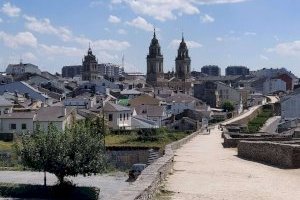
During my visit of Galicia in August 2022, I spent one day in Lugo to explore the town and its two WHS: the Roman walls and its cathedral.
I went there by car, drove under one of the gates and parked within the Roman walls. I first went for a stroll to get a feel of the town and to visit the tourist office, that also offers an interpretation centre for the Walls. Unfortunately, it’s only in Spanish, so I whizzed through looking at some of the pictures about the construction of the wall.
I went for a small walk around the outside of the wall and then did the whole tour of the town on top of the walls starting at the ramp in front of the cathedral, where you will also find a stele with the Unesco symbol. The wall doesn’t offer many places with shade, so a walk on the walls maybe wasn’t the best idea when the sun is at its highest and hottest, but it gave me something to do during the time most of the other sites were closed because of the siesta. There are nice views over the historic centre, but you also have parts where you just see less attractive backs of houses.
To get a better understanding of the Roman history of Lugo, or “Lucus Augusti” as it was called in those days, I visited the Provincial Museum, which has some Roman mosaics and other objects from the …
Keep reading 0 comments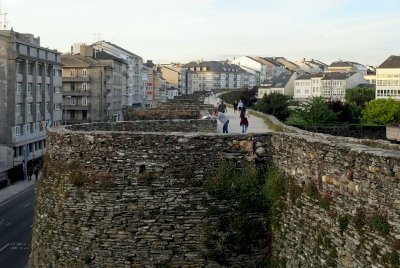
The Romans left a mark on northwestern Spain that can still be seen today in bridges, ancient villages, gold mines, a lighthouse, and, most spectacularly, the Roman Walls of Lugo. I visited the latter when hiking parts of the Camino Primitivo in May 2019. This is one of two World Heritage Sites I visited on that trip to Spain that were famed for their walls (the other, Avila), and I have to say I preferred these walls. I circumnavigated Lugo twice, once following the perimeter at ground level, and once on the ramparts. Both trips gave a good perspective of the walls' height and width, which really must be seen to be appreciated. In the evening, quite a lot of locals come out for exercise jogging or walking around the walls. There's really not a lot more to say about this site -- the walls are remarkably intact and they so far have stood the test of time.
The history of Lugo, however, gave me a greater appreciation for how this corner of the Roman empire fits into world history. Lugo was likely originally named after the Celtic god Lugus, since Gallaecia, now known as Galicia, was home to the Gaels who settled Ireland (and, in fact, you can still hear bagpipes played in Galicia). The town was renamed Lucus Augusti when the Romans came to Galicia to mine gold for use in jewelry, art, and coins. The town became the most important for the Romans in Galicia, and …
Keep reading 0 comments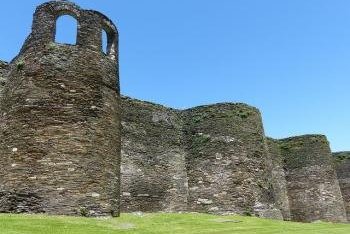
I visited this WHS in June 2016. I walked the whole loop on the walls as well as round the walls from beneath. The Roman walls are really huge, 4m thick and varying between 8 to 12m high. There are 88 towers and 10 gates, 5 dating back to the Romans and the rest added in the 19th century as the population increased. Up until quite recently there were sections of the outer walls to which houses were attached but these have been removed. A visit to the Centro de Interpretación da Muralla de Lugo in Praza do Campo helps to give detailed information on the walls' importance. The only tower with two arches hints to what the towers must have been like in Roman times. Next to the Santiago Gate is a white vertical slab with the UNESCO plaque. The Camino Primitivo and the Camino de Invierno both start or pass through Lugo. I enjoyed my stay in Lugo and I'm glad I stayed for 1 night within the walls. That way I could enjoy Lugo's everyday life from different viewpoints on the walls: from school children playing at lunchtime, people jogging, sunrise, sunset and the walls lit at night.
Keep reading 0 comments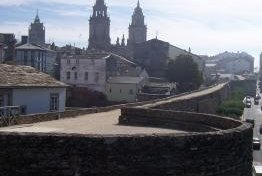
I had a lovely morning strolling along the circuit of walls watching banks of fog roll in and then burn off in the early autumn sun. Like, Els I also encountered lots of joggers, and must admit to being a touch envious that they had such a lovely route to run. The walls can at times be quite high, and it was interesting looking down on the everyday life happening around them much as it has done for the close to 2,00 years since their initial building. It reminded me a little of the Roman castle at Portchester where I grew up, but the walls in Lugo were much larger.
I did spend a little bit of time walking around the town itself which was quite pleasant; the cathedral is evidently based on its much grander cousin in Santiago. Lugo was bi-passed by the main pilgrimage route west (Camino Frances) but features on the earlier Camino Pimativo reflecting the towns age. I had intended to stay a night in Lugo however the draw of the Camino was too strong and I headed off comfortable that I had seen all I wanted to in the 2.5 hours I was in the city.
The walls are very impressive, and their age even more so, there are no towns in Europe that are encircled by a set of defences of this vintage, and as such it is well worth its place on the list and worthy of at least one circuit of its …
Keep reading 0 comments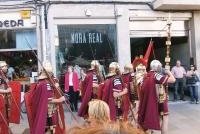
When I arrived in Lugo there were Roman legions parading around the Praza Maior and crowds of people dressed in togas were feasting and imbibing at various stalls. But I would imagine that when not in fiesta mode it is fairly ordinary.
But the town's walls are extraordinary for their thickness, elaborate archways and the continuous walkway around the top.
Keep reading 0 comments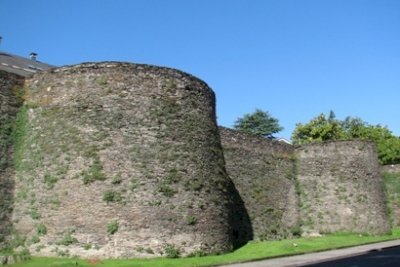
The city of Lugo is located in Galicia, on the route to Santiago de Compostela. I encountered a few pilgrimage cyclists on the way, but no hikers. Lugo's WHS status is for having the only Roman city walls that are both intact (i.e. authentic enough) and entirely complete. In this, they beat the similar ones in Carcassonne, Avila and Le Mans (according to the ICOMOS evaluation at inscription).
My goal for the day was to walk the entire circuit (2km). I accessed the ramparts from the Rua do Teatro. The most amazing thing, at first sight, is how broad this wall is! Four to seven meters wide apparently. It's just like a major road. The only comparison that directly came to my mind is the City Wall of Xi'an in China (it is newer, 14th century, but even wider). If I remember well, they even allow cyclists there.
It's a very fine stroll. It goes up and down slightly, the heights of the wall very between 8 and 12 m. You also get a good look at the city from all sides, although it's a kind of 'railway view' (in plain sight are not the best of houses). I encountered lots of joggers on my walk, some even twice. For a good exercise one has to round the circuit several times.
The entire walk took me about half an hour including photo stops. A quick site to visit! I didn't venture into the city center of Lugo, …
Keep reading 0 comments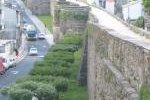
The Roman Walls themselves are enormous and well preserved, you can walk around the city on top of the wall (2,5km). Actually they walls are so huge that they would fit a dual carriageway. If the walls wouldn't be there there aren't many reasons to visit Lugo.
Keep reading 0 comments
